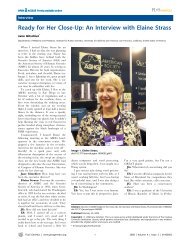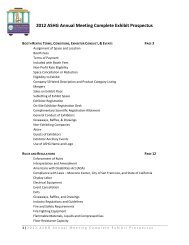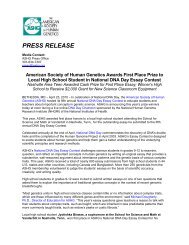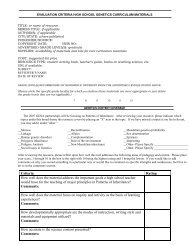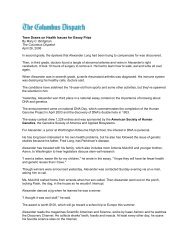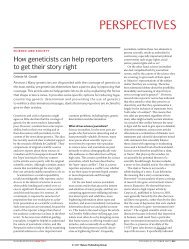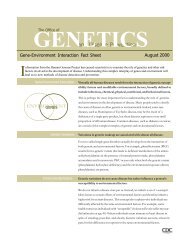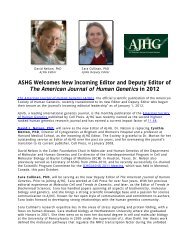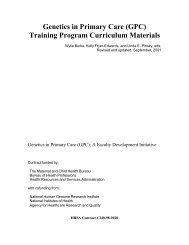ASHG Statement on Professional Disclosure of Familial Genetic ...
ASHG Statement on Professional Disclosure of Familial Genetic ...
ASHG Statement on Professional Disclosure of Familial Genetic ...
Create successful ePaper yourself
Turn your PDF publications into a flip-book with our unique Google optimized e-Paper software.
<str<strong>on</strong>g>ASHG</str<strong>on</strong>g> Subcommittee <strong>on</strong> <strong>Familial</strong> <strong>Disclosure</strong>: <str<strong>on</strong>g>ASHG</str<strong>on</strong>g> <str<strong>on</strong>g>Statement</str<strong>on</strong>g> 481<br />
mendati<strong>on</strong>s that attempt to balance patients’<br />
expectati<strong>on</strong>s <strong>of</strong> privacy with other parties’ claims to sensitive<br />
genetic informati<strong>on</strong>. The majority <strong>of</strong> foreign jurisdicti<strong>on</strong>s<br />
are in favor <strong>of</strong> permitting limited disclosure<br />
<strong>of</strong> genetic test results (without the c<strong>on</strong>sent <strong>of</strong> the patient)<br />
if the potential harm to at-risk relatives is grave and<br />
imminent. Only a few jurisdicti<strong>on</strong>s maintain that c<strong>on</strong>fidentiality<br />
and the patient’s wishes with regard to n<strong>on</strong>disclosure<br />
must be respected without excepti<strong>on</strong>.<br />
Limited disclosure has been recognized at internati<strong>on</strong>al,<br />
regi<strong>on</strong>al, and nati<strong>on</strong>al levels. Internati<strong>on</strong>ally,<br />
both the World Medical Associati<strong>on</strong> (in its “Declarati<strong>on</strong><br />
<strong>on</strong> the Human Genome Project” [44th World Medical<br />
Assembly 1992]) and experts advising the World Health<br />
Organizati<strong>on</strong> (regarding proposed guidelines <strong>on</strong> medical<br />
genetics and genetic services [Wertz et al. 1995]) recommend<br />
that c<strong>on</strong>fidentiality <strong>of</strong> genetic informati<strong>on</strong> be<br />
maintained except where family members are at high<br />
risk <strong>of</strong> serious harm and where disclosure could avert<br />
this harm.<br />
At the regi<strong>on</strong>al level, the Council <strong>of</strong> Europe (1992),<br />
which maintained that c<strong>on</strong>fidentiality <strong>of</strong> genetic informati<strong>on</strong><br />
must be ensured at all times and must be protected<br />
by the rules governing medical data, did make an<br />
allowance for disclosure in the case <strong>of</strong> severe genetic risks<br />
that affect the health <strong>of</strong> family members or their future<br />
children. However, the genetic data <strong>of</strong> <strong>on</strong>e member <strong>of</strong><br />
a couple cannot be communicated without the free and<br />
informed c<strong>on</strong>sent <strong>of</strong> the other member (Council <strong>of</strong> Europe<br />
1990). The 1997 C<strong>on</strong>venti<strong>on</strong> <strong>on</strong> Human Rights<br />
and Biomedicine allows for the communicati<strong>on</strong> <strong>of</strong> genetic<br />
test results when necessary, inter alia, for the interest<br />
<strong>of</strong> public safety, the protecti<strong>on</strong> <strong>of</strong> public health,<br />
or the protecti<strong>on</strong> <strong>of</strong> the rights and freedoms <strong>of</strong> others<br />
(Council <strong>of</strong> Europe 1997).<br />
Nati<strong>on</strong>ally, in the United Kingdom, the Nuffield<br />
Council <strong>on</strong> Bioethics (1993) recommended that accepted<br />
standards <strong>of</strong> c<strong>on</strong>fidentiality <strong>of</strong> medical informati<strong>on</strong> be<br />
followed as much as possible. The council also recommended<br />
that, if a patient refuses to disclose test results<br />
to family members, and if the physician has stressed the<br />
importance <strong>of</strong> sharing such informati<strong>on</strong> and has attempted<br />
to persuade the individual to allow disclosure,<br />
the patient’s desire for c<strong>on</strong>fidentiality may be overridden,<br />
in excepti<strong>on</strong>al circumstances <strong>on</strong>ly. Such decisi<strong>on</strong>s<br />
would be made <strong>on</strong> a case-by-case basis.<br />
The Committee <strong>of</strong> the Health Council <strong>of</strong> the Netherlands<br />
(1989) holds the view that unauthorized disclosure<br />
may be permissible, under limited circumstances,<br />
when serious harm can be avoided. The council has<br />
noted that relatives’ right to privacy should be c<strong>on</strong>sidered<br />
in decisi<strong>on</strong>s as to whether disclosure should be<br />
made.<br />
A recent report <strong>of</strong> the Privacy Commissi<strong>on</strong>er <strong>of</strong> Australia<br />
(1996) recommends that an individual’s right to<br />
privacy give way to the imperative to prevent harm,<br />
where the risk is serious, real, and imminent and “where<br />
there is a possibility <strong>of</strong> effective interventi<strong>on</strong> and the<br />
c<strong>on</strong>sequences <strong>of</strong> n<strong>on</strong>interventi<strong>on</strong> are serious for affected<br />
relatives.” 26<br />
The Japan Society <strong>of</strong> Human <strong>Genetic</strong>s (1996), in its<br />
“Guidelines for <strong>Genetic</strong> Testing,” also stipulates that,<br />
where necessary to avoid serious injury, c<strong>on</strong>fidentiality<br />
can be broken, even in the absence <strong>of</strong> (subject) c<strong>on</strong>sent.<br />
However, such an excepti<strong>on</strong> must be made by a resp<strong>on</strong>sible<br />
ethics committee.<br />
Other jurisdicti<strong>on</strong>s are explicit in making no allowances<br />
for unauthorized disclosure. Norway, for instance,<br />
has taken a clear and firm legislative stand <strong>on</strong> protecting<br />
pers<strong>on</strong>al privacy, with no excepti<strong>on</strong>s made for disclosure,<br />
even under extreme circumstances. 27<br />
The Swiss Academy <strong>of</strong> Medical Sciences (1993) and<br />
France’s Nati<strong>on</strong>al Ethics Committee (1991) have established<br />
guidelines that do not permit disclosure without<br />
the patient’s c<strong>on</strong>sent. 28 However, in its reiterati<strong>on</strong> <strong>of</strong> this<br />
principle in 1995, the French Nati<strong>on</strong>al Ethics Committee<br />
noted that, given the principle <strong>of</strong> assistance to pers<strong>on</strong>s<br />
in danger, in the event <strong>of</strong> a research subject’s refusal, the<br />
physician is c<strong>on</strong>fr<strong>on</strong>ted with an ethical dilemma that<br />
must be resolved, particularly where children are involved.<br />
29<br />
In 1995, the members <strong>of</strong> the House <strong>of</strong> Comm<strong>on</strong>s Science<br />
and Technology Committee (1995) disagreed with<br />
the Nuffield Council’s suggesti<strong>on</strong> that c<strong>on</strong>fidentiality<br />
should be less than absolute. The committee holds the<br />
26<br />
Privacy Commissi<strong>on</strong>er <strong>of</strong> Australia (1996, p. 33-35. See also Medical<br />
Research Ethics Committee <strong>of</strong> the Nati<strong>on</strong>al Health and Medical<br />
Research Council (NHMRC) (1991), who noted that their recommendati<strong>on</strong><br />
to respect the wishes <strong>of</strong> the individual tested was still c<strong>on</strong>tentious<br />
when the guidelines were written. They noted that it could<br />
well be argued that the right <strong>of</strong> the pers<strong>on</strong> at risk should outweigh<br />
privacy when there is a possibility either that a life could be saved or<br />
that a c<strong>on</strong>diti<strong>on</strong> could be effectively treated, if the informati<strong>on</strong> were<br />
disclosed to the at-risk relative (p. 4).<br />
27<br />
Norway Ministry <strong>of</strong> Health and Social Affairs (1993); Norway<br />
(1994). The Ministry <strong>of</strong> Health and Social Affairs determined “that<br />
informati<strong>on</strong> <strong>on</strong> the genes <strong>of</strong> people regarded as healthy must remain<br />
strictly c<strong>on</strong>fidential. Such informati<strong>on</strong> must not be stored, not even<br />
by health instituti<strong>on</strong>s in patient records” (p. 64-65).<br />
28<br />
Comité C<strong>on</strong>sultatif Nati<strong>on</strong>al d’Éthique pour les Sciences de la Vie<br />
et de la Santé (1991); Swiss Academy <strong>of</strong> Medical Sciences (1993, guideline<br />
3.7); Law 94-654 (29 July 1994) On the d<strong>on</strong>ati<strong>on</strong> and use <strong>of</strong><br />
elements and products <strong>of</strong> the human body, medically assisted procreati<strong>on</strong>,<br />
and prenatal diagnosis (1994) 45:4 Int Digest Health Legis 473,<br />
Title VI, A.L. 145-15.<br />
29<br />
Comité C<strong>on</strong>sultatif Nati<strong>on</strong>al d’Éthique pour les Sciences de la Vie<br />
et de la Santé, Avis 46 (7 novembre 1995) Génetique et médecine: de<br />
la prédicti<strong>on</strong> à la préventi<strong>on</strong>, rec. 2. The ethics report accompanying<br />
this opini<strong>on</strong> noted both the importance <strong>of</strong> genetic informati<strong>on</strong> for<br />
subsequent generati<strong>on</strong>s and the possible duty <strong>of</strong> the physician to disclose<br />
genetic informati<strong>on</strong>, when useful, to pers<strong>on</strong>s at risk (R. 3.3).



